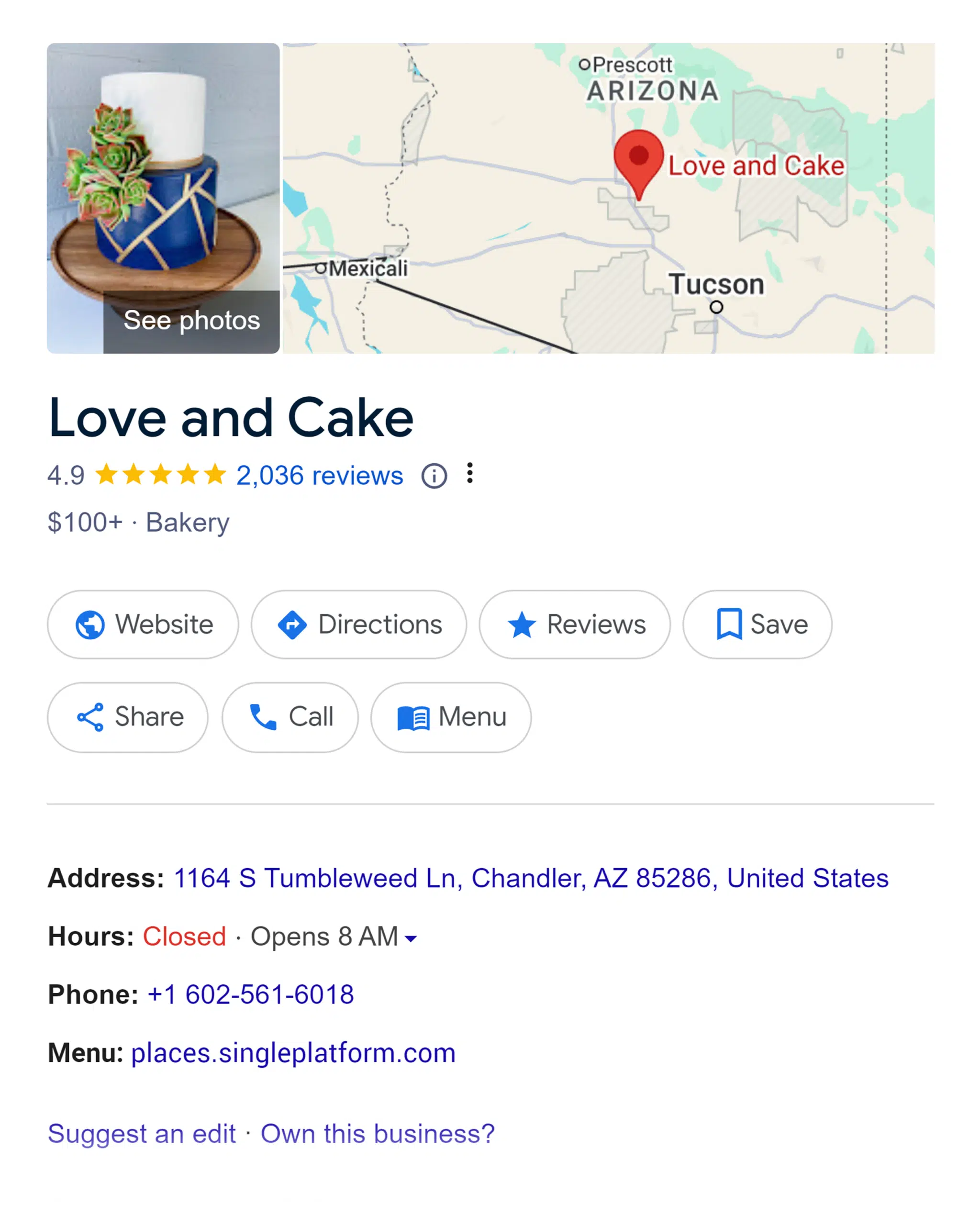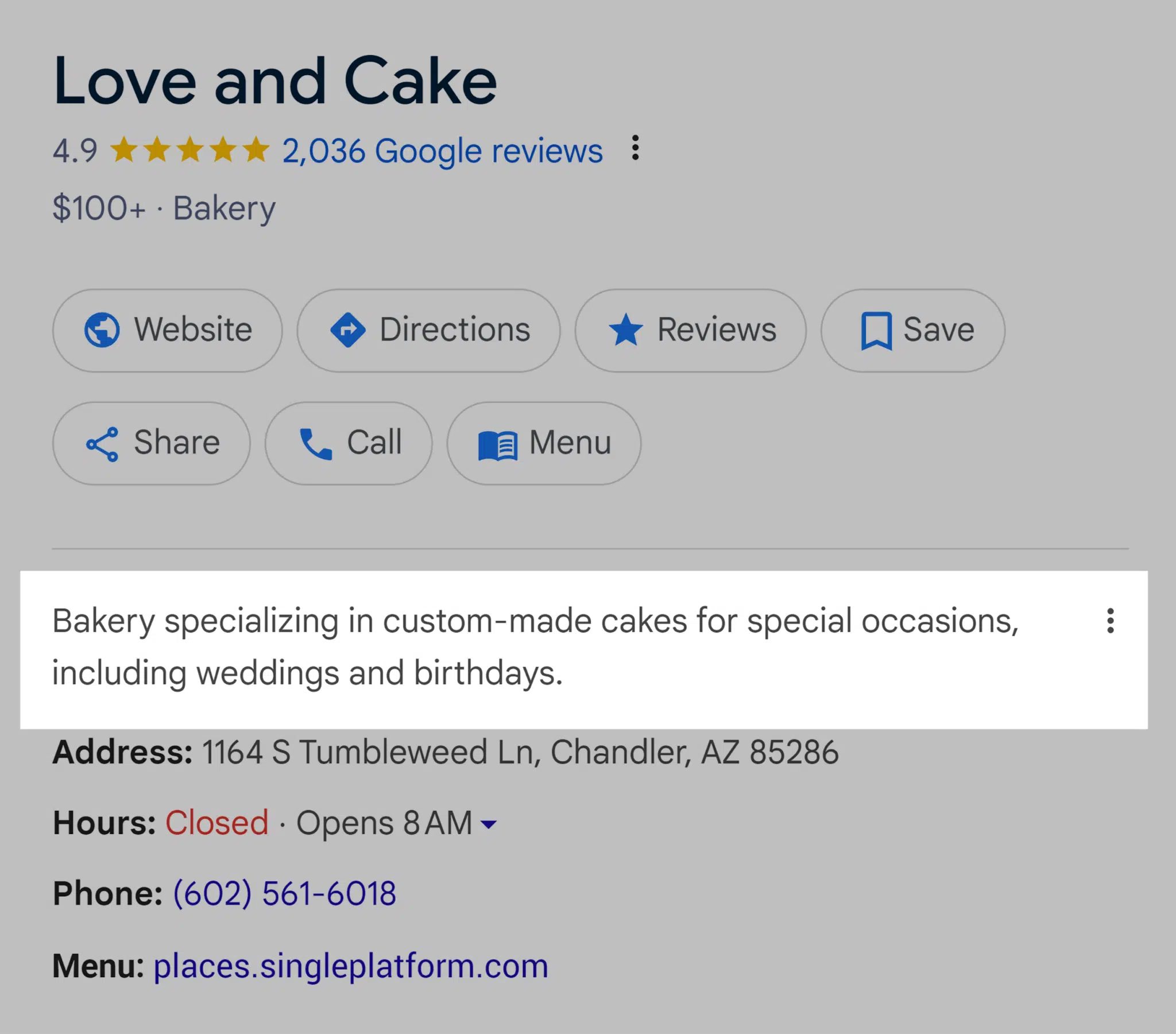Google test doubles down on the priority of your review content
Sponsored by Semrush, written by Miriam Ellis, edited by Nichola Stott
One liability of a long career in local search marketing is becoming nonchalant about the fact that Google’s constantly running tests of new Google Business Profile features. You catch a glimpse of something new, mutter to yourself, “Testing again,” take a screenshot, and move on, knowing that what you’ve spotted may never experience a wide rollout.
Once in awhile, though, you see a test that stops you in your tracks, like this recent About this place experiment spotted by Khushal Bherwani:

The six-panel display surfaces reviews, ratings, profile images, time stamps, and some review-based photos, as well as a system of review-sorting tabs which resembles (but is not identical to) the Place Topics tabs that exist on the main Google Business Profile review display.
This test appeared on the listing of a bakery in Chandler, Arizona, and I’ve been unable to reproduce it on the following Google Business Profile (GBP), though the original poster has confirmed for me that he’s still encountering this feature in several listings:

Despite the limited nature of the experiment and the impossibility of predicting whether this new feature will go live in future, I consider it a rare test that’s worth studying for its insight into Google’s perspective on local search.
A window into the local mind of Google
The description field is one of the oldest features of Google listings—it’s intended to give the business owner a chance to introduce their own brand. The above screenshot shows a typical description (in this example, for a local bakery).

History tells us that Google has never been completely satisfied with this listing element. Owner-provided descriptions originally featured prominently on GBPs, but at one point they became invisible, only to return later near the bottom of these panels.
I’m not alone in feeling that Google’s haphazard handling of the description field reveals a lack of trust in the authority of the local business owners whose content powers their index. A respectful stance would be to assume that the founder of a local enterprise knows best how to describe their own company, and that this directly-sourced information from the business should take pride of place in listing architecture.
Instead, Google demotes this content to the lower regions of GBPs, instead showcasing AI-generated descriptions at the top:

Local enterprise owners and marketers might justly take offense at the implication that bots infamous for making astonishing blunders know more about their brands than they do. This particular AI description appears to be factually correct, but it lacks the human verve seen in the human-written description.
It appears that Google is struggling to find a way to resolve its seeming mistrust of the local business owners it represents, and perhaps we see them reaching for a possible solution in the test feature captured by Bherwani. The placement of this grid above the traditional description and its label of “About this place” suggests that Google sees the public as a more authoritative source than business owners for “about us”-type content.
It’s a test which begs the question: Is Google’s stance on this logical?
Google’s faith in UGC
Some of the numbers are on Google’s side. Surveys routinely turn up statistics along the lines of 9 out of 10 consumers trusting what customers say about a business more than what a business says about itself. Given such data, Google may be right to devote premium space to the massive body of user generated content (UGC) they’ve collected in the form of reviews.
However, the widespread and well-documented issue of review spam should challenge both Google and the consumer public to reconsider whether what apparent customers say about a business is more reliable than brand messaging.
Even a brief visit to the Google Business Profile Help Community suggests that the number of businesses coping with fake reviews attacks is massive:

Meanwhile, Curtis Boyd of the Transparency Company estimates that 18% of the reviews in Google’s system are clearly fraudulent, and that 40% are suspicious to some extent. Review spam is present across all industries, with verticals like home services and legal being especially impacted. This type of spam consists of bad actors seeking to either boost the reputation, ratings, and local rankings of their own brands or to harm those of their competitors.
Occasionally, review fraud scandals make headlines, but for the most part, they tick along unnoticed by the consumer public and unaddressed by Google. As Boyd states of reporting review spam:
“Communicating with Google is very difficult or impossible, and getting them to admit that these reviews are fake is often a massive struggle.”
This scenario points to a societal hazard stemming from the offline-to-online transition we’ve undergone over the past few decades. Fifty percent of consumers say they trust online reviews as much as personal recommendations from family and friends.
If your cousin or next-door neighbor mentions over coffee that a certain local business did a great job repairing their garage door, it’s highly unlikely that they’ve been paid for this endorsement, and even more implausible that they’re somehow impersonating your relative or acquaintance. Putting the same level of trust in random online review profiles is naive, given the scale of review fraud.
Thus, while consumer trust statistics indicate that Google would be right to fully roll out the About this place experiment, giving even greater prominence to review UGC, review fraud estimates suggest that the feature would potentially highlight a concerning percentage of fake reviews. Nevertheless, nearly all local brands must dance to Google’s tune because of their monopoly status.
How your local enterprise should respond to Google’s test
Despite the problem with review fraud, the About this place test signals that developers at Google are being tasked with finding new ways to utilize review content. The takeaway for your enterprise is that priority should be allotted to review-oriented local search marketing strategy so that a significant portion of your reviews are legitimate, however Google chooses to organize and highlight them.
At minimum, your brand should be able to check off every item on the following list across all of your locations:
Reputation management minimum checklist
- Active, guideline-compliant Google Business Profile review acquisition strategy in place
- Active monitoring of incoming reviews for fast response and early spam detection
- Responding to all legitimate-seeming reviews within 2-3 days
- Reporting fraudulent reviews that violate Google’s prohibited and restricted content guidelines via the process demonstrated in the video on this Google resource document
- Monitoring the success of fake review removal via the Google Reviews Management Tool and appealing denied requests
- Monitoring geographic markets for signs of competitor review fraud and reporting obvious spam
- Analyzing review sentiment trends over time to detect both emergent structural problems at specific business locations as well as patterns of suspicious review behavior
- Accessing legal counsel in the instance of serious review fraud
Reprioritizing your enterprise’s reputation resources
If you’re currently seeking to earn greater buy-in at your organization for a more sophisticated approach to reputation management, including the acquisition of more staff and appropriate software for scaling the necessary work, consider sharing these points at your next meeting:
- GBP reviews have a direct impact on reputation, rankings, revenue, user behavior, traffic, and conversions. Brand profitability is inextricably linked to this specialized form of UGC, requiring management resources.
- The problem of review fraud is widespread and represents a major threat to brands. Continuous monitoring is necessary to identify and report review spam and minimize harm.
- The majority of consumers expect responses to their reviews. Reputation management has become a significant component of customer service, so enterprises must efficiently scale the response process.
A stroll through Google Maps makes it startlingly clear how many of even the largest enterprises are leaving the review scenario up to chance. Big brand profiles are riddled with neglected complaints and apparent spam, eroding the average star ratings upon which consumers base decisions when they’re on the verge of making local transactions.
Reviews have an extraordinary power to benefit local enterprises, but unmanaged profiles can quickly become brand detriments. In this light, Google’s recent test of the About this place feature should be viewed as a memo to your org to devote more resources than ever to the stewardship of your online reputation via well-planned and executed review management.